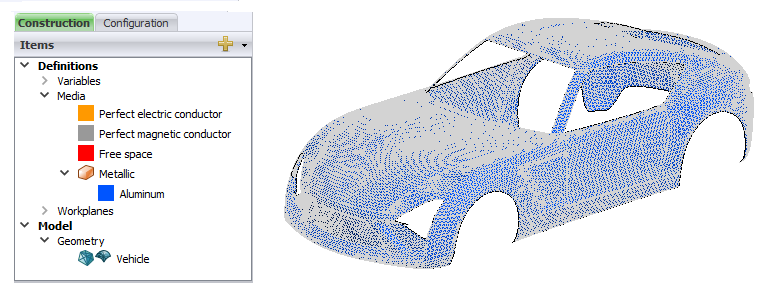Importing the Platform Mesh into CADFEKO
The mesh of the platform (.fhm file) is imported into CADFEKO model containing the antenna.

Figure 1. 3D view of the imported .fhm showing the imported mesh and its media properties.
最新のリリースで新規に追加された機能の紹介です。
Feko Getting Started Guideでは、Fekoをはじめて使用する場合に必要となる部分を手順を追って紹介します。
Feko Example Guideでは、Fekoのコンセプトと基本を学ぶための例題集を掲載しています。
Fekoは、任意形状の3Dオブジェクトを含む電磁界解析に使用される複数の解法を備えた包括的な電磁気ソルバーです。
CADFEKOを使用して、グラフィカル環境で形状またはモデルのメッシュを作成およびメッシングし、解析設定と計算要求を指定します。
POSTFEKOはFekoのポストプロセッサであり、モデル(設定とメッシュ)、グラフ上の結果、3Dビューの表示に使用します。
EDITFEKOは、ループや条件文を含む高水準のスクリプト言語を使用して(形状要件と解析要件の両面で)高度なモデルを構築するために使用されます。
Fekoの主な特長として、独自の解析方法と復号化した解析方法が幅広く用意されていることが挙げられます。Fekoの機能を効果的に使用するには、使用可能な手法を理解する必要があります。
Fekoは、遺伝的アルゴリズム(GA)などの手法に基づく最先端の最適化エンジンを提供します。これを使用することにより、設計を自動的に最適化し、最適解を決定することができます。
Fekoのユーティリティは、PREFEKO、OPTFEKO、ADAPTFEKO、Launcher ユーティリティ、アップデーター、およびクラッシュレポーターで構成されています。
Fekoでは、すべての結果が、ASCII出力ファイル.outと、POSTFEKOで使用するバイナリ出力ファイル.bofに書き込まれます。解析に関する追加情報を入手するには.outファイルを使用します。
アプリケーションマクロは、CADFEKOとPOSTFEKOで利用可能です。
CADFEKOとPOSTFEKOでは、高機能、高速で軽量なスクリプト言語がアプリケーションに組み込まれています。この言語を使用すると、モデルの作成、シミュレーション結果やモデル設定情報の取得、データの操作、繰り返し処理の自動化などが実現します。
Reference information is provided in the appendix.
CADFEKO and POSTFEKO have a powerful, fast, lightweight scripting language integrated into the application that allows you to create models, get hold of simulation results and model configuration information and much more.
Each geometry and calculation request are entered on a separate line in the .pre and are referred to as cards.
A collection of how-tos are included that covers advanced concepts.
Fekoは、ジョブのスケジューリングとキューイングのシステムに統合できます。このようなシステムとして、Altair PBS Professional、Torque、IBM Platform LSF、Parallelnavi NQS、SLURM、Univa Grid Engineなどがあります。
A method is presented on how to feed a grounded coplanar waveguide (GCPW) in CADFEKO. The same method can be used to feed a coplanar waveguide (CPW).
A method is presented that allows you to estimate the memory requirements for a model solved using the マルチレベル高速多重極法 (MLFMM).
A method is presented on how to construct a conformal patch antenna in CADFEKO.
A method is presented on how to construct and feed a complementary slotted two-arm spiral antenna in CADFEKO.
The MLFMM is an iterative solution method, and under certain conditions, the iterative solution may fail to converge. Several model or solution settings are presented that could improve the model's convergence behaviour.
The hybrid マルチレベル高速多重極法 (MLFMM) / 有限要素法 (FEM) is an iterative solution method and under certain conditions, the iterative solution may fail to converge. Several model or solution settings are presented that could improve the model's convergence behaviour.
The hybrid モーメント法 (MoM) / 有限要素法 (FEM) is an iterative solution method, and under certain conditions, the iterative solution may fail to converge. Several model or solution settings are presented that could improve the model's convergence behaviour.
The 時間領域差分法 (FDTD) is a solution method that may fail to converge under certain conditions. Several model or solution settings are presented that could improve the model's convergence behaviour.
Several tips and tricks are presented to reduce runtime and memory consumption. A few general tips are given as well as solution method-specific tips.
Various methods are presented on how to feed a microstrip line using an infinite planar multilayer substrate in CADFEKO.
A workflow is presented on how to connect an antenna model designed in CADFEKO to a platform model that was meshed with Altair HyperMesh.
The mesh of the platform is exported to a Feko HyperMesh (.fhm) file which contains the mesh elements, material properties, and assignment data.
To ensure mesh connectivity between the antenna mesh and platform mesh in the steps that follow, create a base for the antenna that will protrude and intersect the platform.
The mesh of the platform (.fhm file) is imported into CADFEKO model containing the antenna.
The antenna is placed on the platform and remeshed.
The full model (antenna and platform) is exported to a Feko HyperMesh (.fhm) file.
The platform and antenna base are unioned using the Mesh Boolean tool and remeshed.
The connected antenna mesh and platform mesh are imported into CADFEKO and simulated.
When meshing a model, you can either use the automatic meshing algorithm to calculate the appropriate mesh settings or you can specify the mesh sizes. When you specify the mesh sizes, the mesh sizes should adhere to certain guidelines.
Feko makes use of a local peak SAR algorithm.
Control the execution of Feko by specifying the memory management and environment variables.
The .mat file, .lud file and .rhs file are not generated by default, but can be read externally.
Feko integrates with various products within Altair Simulation Products such as HyperStudy. Integration with third-party products is also supported through the powerful scripting and plug-in infrastructure.
Use the correct structure, convention and syntax for a SPICE circuit definition in Feko.
View the list of commonly used acronyms in Feko.
Feko creates and uses many different file types. It is useful to know what is stored in the various files and weather they were created by Feko and if it is safe to delete them. The files are grouped as either native files that have been created by Feko or non-native files that are supported by Feko. Non-native files are often exported by Feko even if the formats are not under the control of the Feko development team.
A Feko Errors, Warnings and Notes Reference Guide is available as a reference for messages that may be encountered in Feko.
Reference information is provided in the appendix.
A collection of how-tos are included that covers advanced concepts.
A workflow is presented on how to connect an antenna model designed in CADFEKO to a platform model that was meshed with Altair HyperMesh.
The mesh of the platform (.fhm file) is imported into CADFEKO model containing the antenna.
The mesh of the platform (.fhm file) is imported into CADFEKO model containing the antenna.

(c) 2021. Altair Engineering Inc. All Rights Reserved.